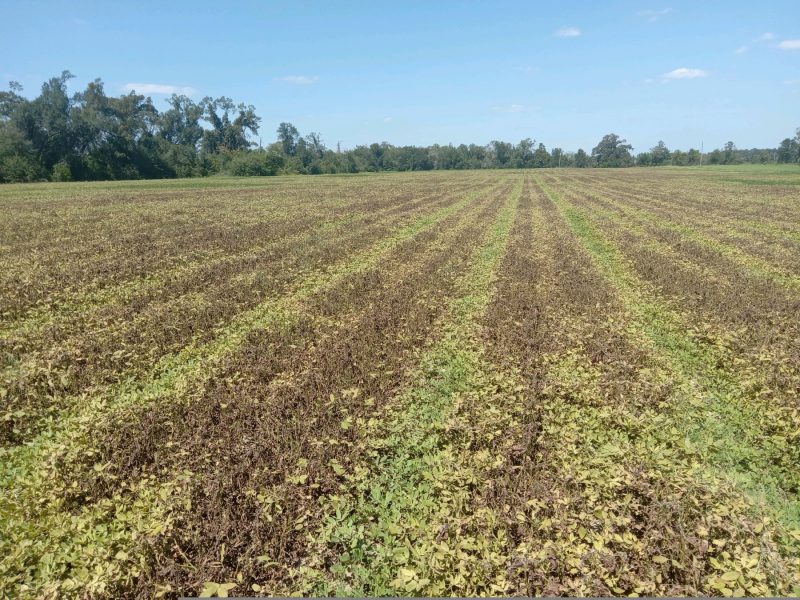
Peanut field devastated by spider mites after a pyrethroid insecticide was sprayed. Photo Credit: Ethan Carter, UF/IFAS
We’ve made it to Fall and pleasant surprise, it actually feels fall-like outside (at least by Florida standards). As you would expect, with us moving into Fall we are seeing the peanut growing season really starting to wind down. Unfortunately, the hand that the environment has delt many growers is putting a damper on the excitement the generally accompanies the beginning of harvest and somewhat cooler weather. Drought stress, disease, and pest pressure have combined to lead to generally poor vine condition in many fields. This makes conversations about optimizing harvest timing even more complicated than they would have already been. There is a lot of “not good” stuff going on in peanut fields right now – white mold is rampant, stressed plants are giving in to late season TSWV, spider mites are as plentiful, and it has quit raining again. I understand there will be plenty of fields dug early, because they have to be. That said, on fields you think you can hold together, try; because if it’s a rain-fed field it’s probably not as mature as you think it is.
Two quick notes, relating to the comments above.
- DO NOT spray spider mites with a pyrethroid insecticide – it will make the problem worse. If you are not sure if a product is, or is not a pyrethroid call your Extension Agent.
- As you get close to harvest time be conscious of the Pre Harvest Intervals on your crop protection products.
–
Fields are all over the place in terms of the rate of maturity (more on that below). Please find a field on the aGDD Tracker below that is analogous to yours in terms of planting date and approximate location. If the number of aGDDs shown is in yellow or black, before you dig you really need to have a good representative sample pod-blasted to confirm the field is as mature as you think/hope it is. Call your local UF/IFAS Extension Office for help with this process.
aGDD Tracker for the Florida Peanut Producing Region – 9/22/23 edition
The aGDD Tracker is compiled from data generated by PeanutFARM.org. The dark blue bars in the cells with the aGDD values indicates progress towards 2500 aGDDs. The bar extends to the right as aGDDs are accumulated. The entire cell will be dark blue when a field has accumulated 2500 aGDDs. It is recommended that fields be sampled and exact days-to-harvest be determined via pod-blasting once a field reaches 2300 aGDDs.
–
Analyzing the aGDD Tracker
Looking at this week’s aGDD Tracker, there are some factors that that standout and a few more that you’ll have to look closely to notice. First, the difference in the rate of aGDD accumulation between rain-fed and irrigated fields continues to be hugely evident. Even though we are not quite as dry as we were some weeks back, we are still dry (as we have been the majority of the growing season) and irrigated fields are out pacing rain-fed fields by a minimum of 300 aGDDs. Take for example, May 5 planted fields around Marianna. At 140 days after planting a fully irrigated (0 drought stress) field is showing 2789 aGDDs – well past optimum maturity, while a rain-fed field is only showing 2342 aGDDs – time to pod-blast, but probably not ready for harvest. Fields that have had plenty of water are tracking ahead of the 140 day rule-of-thumb while rain-fed fields are behind. The effects of drought stress can also be seen in the Tracker by comparing rain-fed fields in different locations. The eastern counties of the Panhandle have not been as dry as the central or western. While the Jay and Marianna fields are generally within 20 aGDDs of each other (especially for the later planting dates) the Monticello fields are 80-100 aGDDs ahead.
What do these spreads in aGDDs actually mean? As it turns out, with cooler, shorter, dry days these spreads in aGDDs mean more and more of a spread in the expected number of calendar days until optimal harvest time. Across the whole season you would expect a crop to accumulate 18 aGDDs +/- per calendar day. Due to the conditions listed previously, between the 9/8/23 edition and the 9/22/23 edition the fields in the Tracker have only averaged about 14 aGDDs per calendar day. Going back to our previous example of a rain-fed field in Marianna planted 5/5, that field has accumulated 2342 aGDDs at 140DAP. The fields still needs 158 more aGDDs to reach the target of 2500 aGDDs. At 14 aGDDs per calendar day that’s 11 more days (151 DAP). Apply this same math to the aGDD spreads we see between rain-fed and irrigated fields ands we’re talking about 3+ weeks difference in time to optimum maturity.
- Peanut Maturity Update – 10/9/25 - October 10, 2025
- Fall Can be a Great Time for Vegetation Management - October 3, 2025
- Peanut Maturity Update – 9/25/25 Edition - September 26, 2025
